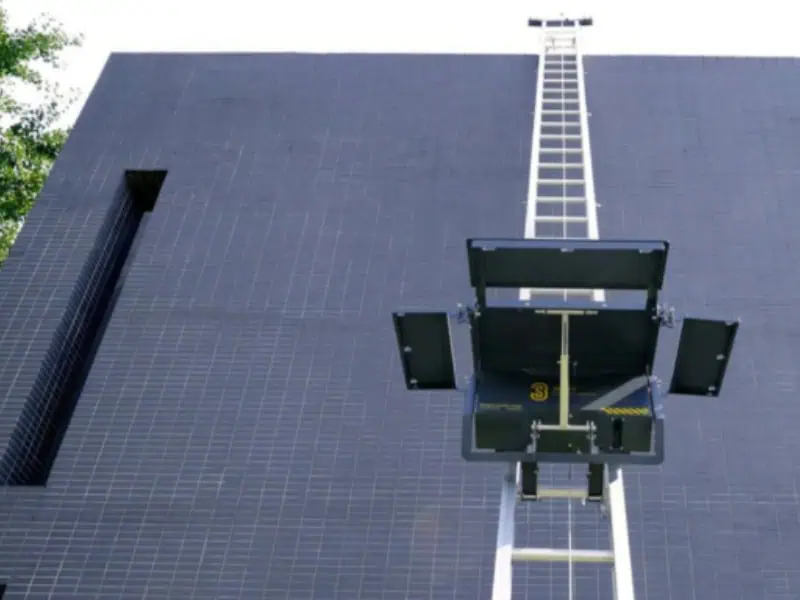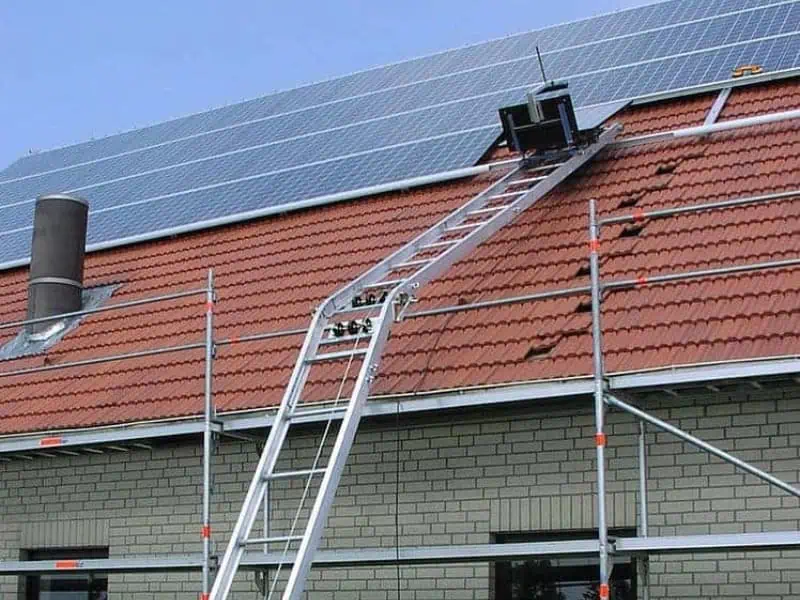Reliability, control, and compact access make a ladder elevator ideal for roof-height work, especially when sites are tight and schedules are chock-full. By shifting heavy, repetitive handling to a ladder elevator, roof crews gain predictable flow without skirting safety. Materials reach height with fewer trips, steadier pacing, and cleaner exclusion zones. On low-rise builds, rails set up fast and hug narrow setbacks, keeping neighbours happy and trades moving. This article explains where these systems shine, how to size them, and which features, setups, and workflows deliver the best outcomes for Australian jobsites.
How does a ladder improve safety compliance on construction sites?
A ladder elevator supports compliance by removing the need for risky hand-carrying and controlling the lift path from ground to roof. It brings order to the job, so induction, SWMS, and spotter roles align with actual practice rather than workarounds. On Australian jobsites, a ladder hoist from Conveying & Hoisting Solutions is often referenced in SWMS and lift plans to identify the equipment in use. Here are the safety compliance advantages:
- Three points of contact: Ground-level loading requires workers to maintain three points of contact on scaffold stairs.
- Exclusion zones: Predictable lift lines help set no-go areas and signage that people actually follow.
- Fewer improvisations: Clear controls reduce rope-and-bucket shortcuts that breach site rules.
- Incident reduction: The lower chance of dropped objects helps protect pedestrians and lower roofs.
- Reduced fatigue: Fewer long carries at height translate to alert operators during critical tasks.
- Cleaner housekeeping: Defined laydowns at height control tripping hazards around the roof edge.
Concretely, crews see reduced manual handling injuries when materials arrive at height without awkward carries. For a spec that aligns with practical site controls, consider trusted ladder elevator solutions for roof-height construction work. Then, integrate the lift plan into pre-starts and toolbox talks to ensure the procedure is consistently followed across shifts. With a tidy process, supervisors can keep everyone on the same page—no worries.
What load capacities and height limits can a ladder elevator handle safely?
Capacity and height decide fit for purpose. As a rule of thumb, compact units are suitable for lighter loads over modest heights; modular sets scale to two-storey reaches and bulkier bundles. Here are the sizing considerations:
- Rated payloads: Account for packaging, wet materials, and wind effects on broad sheets.
- Rail angle: Real-world setups may be limited by payload and rail angle; keep gradients within the manual.
- Tie-ins and base: Use outriggers, ballast, or structural tie-offs to maintain stability.
- Cycle planning: Short, repeatable cycles reduce queueing at the roof edge and maintain a smooth flow.
- Clearance checks: Confirm soffits, gutters, and overhead lines will not foul the carriage path.
- Surface conditions: Level the base on firm pads to stop creep, especially on damp or soft ground.
Informative table — indicative specifications (confirm the data plate on the day):
| Ladder elevator type | Typical payload (kg) | Max height (m) | Best for |
| Compact portable | 80–120 | 6–8 | Repairs, light materials, tight access |
| Mid-size modular | 150–200 | 10–14 | Tiled roofs, multi-trade feeds |
| Heavy-duty modular | 250–300 | 16–20 | Two-storey re-roofs, bulky bundles |
To sharpen risk controls alongside these specs, review the guidelines for preventing ladder-related falls on construction sites, and then confirm rail angles and tie-ins during setup. With the correct geometry and anchoring, lift cycles stay smooth even when the afternoon breeze kicks up. Always weigh the heaviest expected bundle, and remember that frequent lighter cycles usually beat oversized, wobbly loads on gusty days.
What features distinguish a ladder elevator from standard ladder lifts?
While standard ladder lifts move materials, elevator-grade units improve control, stopping, and carriage stability. That difference matters when loads are heavier, heights are longer, or neighbours are keen to keep noise down. Here are the differentiating features:
- Variable-speed drive: Soft starts and stops protect loads and gutters.
- Positive braking: Carriage holds position for stable lifting on uneven ground and gusty conditions.
- Safety interlocks: Limit switches prevent over-travel and help enforce SWMS steps.
- Purpose-built carriages, including tile crates, sheet cradles, and tool bins, reduce changeovers.
- Remote or pendant controls: Operators stand clear with clean sightlines to the lift path.
- Modular rails: Quick pins and joints speed repositioning as scaffold stages move.
These features turn ad-hoc lifting into a predictable workflow, trimming faff at the roof edge and easing scaffold congestion. For details on controls and typical outcomes, consider knowing how hoists improve safety on construction job sites. With better control, crews stay on the tools while the lift feeds materials at a steady clip. Stronger carriages and limit switches also help protect roof membranes and gutter lines from overruns and hard stops.
When should builders use ladder lifts or hoists instead of an elevator system?

Not every job needs elevator-level control. For light, occasional lifts or short reaches, a basic ladder hoist can be a better tool. For heavier payloads, longer rails, and multiple trades feeding the roof, the elevator’s control pays back quickly. Here are the selection cues:
- Scope and frequency: Small repairs and quick swaps suit hoists; ongoing feeds suit elevators.
- Load profile: Bulky, heavy, or fragile items benefit from smoother control.
- Access constraints: Narrow side yards and fragile driveways favour compact, modular rails.
- Program impact: Consistent feed reduces idle time for roofers and follow-on trades.
- Noise and neighbours: Quieter drives keep early starts friendly in dense streets.
- Attachments: Sheet clamps and tile cages raise versatility without risky improvisations.
For a practical decision tree that maps equipment to job scope, timing, and constraints, know when to use a ladder hoist on construction projects, then select the smallest device that meets your heaviest lift.
Does using a ladder elevator reduce labour costs and project time?
A well-matched system shortens carry time, smooths sequencing, and reduces congestion on scaffold stairs. That steadier rhythm translates into measurable savings in labour hours across a day, then across a program. Here are the productivity advantages:
- Single operator feed: One ground operator keeps multiple roof trades supplied.
- Predictable cycles: Regular deliveries let roof crews plan work in tidy blocks.
- Fewer bottlenecks: Reduced stair traffic and fewer cross-overs minimise delays and near misses.
- Less fatigue: By reducing carrying, workers can stay sharp for detailed tasks.
- Better sequencing: Batch by roof zone to trim double-handling and idle waits.
- Cleaner interfaces: Clear lift windows prevent clashes with painters and sparkies.
Final thoughts
Two problems dominate roof-height work: moving heavy materials safely and keeping pace without risky shortcuts. Agitate that picture briefly—gusty winds, a narrow side yard, and end-of-day fatigue can turn basic lifts into hazards. The practical solutions are straightforward: right-size the device to your heaviest load and most extended reach, lock in a simple lift plan with a named operator and spotter, stage laydowns so the roof team never waits, and maintain rails, pins, tie-ins, and braking at the start of every shift. Choose the system that fits the site geometry, document the controls in the SWMS, and keep the path clear from base to roof so the day runs on rails. For tailored guidance that fits height, payload, and access constraints, learn how Conveying & Hoisting Solutions simplifies roof-height lifting projects and includes photos or measurements so the advice lands spot-on.




